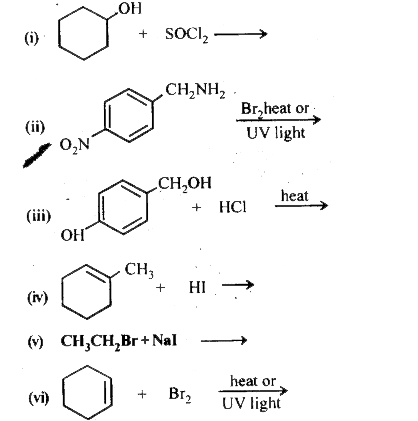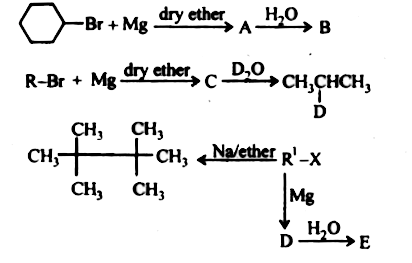Complete Solutions to Exercise of chapter HALOALKANES AND HALOARENES of Class 12 book with complete answers and questions
| Class 12 | CHEMISTRY |
| Chapter | HALOALKANES AND HALOARENES |
| NCERT | Exercise |
| Number Of Questions | 31 |
| Academic Year | 2023-24 |
Write structures of the following compounds:
(i) 2-Chloro-3-methylpentane
(ii) 1-Chloro-4-ethylcyclohexane
(iii) 4-tert. Butyl-3-iodoheptane
(iv) 1,4-Dibromobut-2-ene
(v) 1-Bromo-4-sec. butyl-2-methylbenzene.05:10View SolutionWhy is sulphuric acid not used during the reaction of alcohols with KI?
03:02View SolutionWrite structures of different dihalogen derivatives of propane.
06:22View SolutionAmong the isomeric alkanes of molecular formula `C_(5)H_(12)`, identify the one that on photochemical chlorination yields
(i) A single monochloride.
(ii) Three isomeric monochlorides.
(iii) Four isomeric monochlorides.07:48View SolutionDraw the structures of major monohalo products in each of the following reactions:
 11:19View Solution
11:19View SolutionArrange each set of compounds in order of increasing boiling points.
(i) Bromomethane, Bromoform, Chloromethane, Dibromomethane.
(ii) 1-Chloropropane, Isopropyl chloride, 1-Chlorobutane.03:34View SolutionWhich alkyl halide from the following pairs would you expect to react more rapidly by an SN2 mechanism? Explain your answer.
`(i) CH_(3)CH_(2)CH_(2)CH_(2)Br or CH_(3)CH_(2)underset(Br)underset(|)C HCH_(3) , (ii) CH_(3)CH_(2)underset(Br)underset(|)CHCH_(3) or H_(3)C-underset(CH_(3))underset(|) overset(CH_(3))overset(|)C-Br`
(iii)` CH_(3)underset(CH_(3))underset(|)CHCH_(2)CH_(2)Br or CH_(3)CH_(2)underset(CH_(3))underset(|)CHCH_(2)Br`05:03View SolutionIn the following pairs of halogen compounds, which compound undergoes faster `S_(N)1` reaction?
 06:45View Solution
06:45View SolutionIdentify A, B, C, D, E, R and `R^(1)` in the following:
 04:51View Solution
04:51View SolutionName the following halides according to IUPAC system and classify them asalkyl, allyl, benzyl (primary, secondary, tertiary), vinyl or aryl halides:
(i) `(CH_(3))_(2)CHCH(Cl)CH_(3) , (ii) CH_(3)CH_(2)CH(CH_(3))CH(C_(2)H_(5))Cl`
(iii) `CH_(3)CH_(2)C(CH_(3))_(2)CH_(2)I , (iv) (CH_(3))_(3)C CH_(2)CH(Br)C_(6)H_(5)`
(v) `CH_(3)CH(CH_(3))CH(Br)CH_(3) , (vi) CH_(3)C(C_(2)H_(5))_(2)CH_(2)Br`
`(vii) CH_(3)C(Cl)(C_(2)H_(5))CH_(2)CH_(3) , (viii) CH_(3)CH=C(Cl)CH_(2)CH(CH_(3))_(2)`
(ix) `CH_(3)CH=CHC(Br)(CH_(3))_(2) (x) p-ClC_(6)H_(4)CH_(2)CH(CH_(3))_(2)`
(xi) `m-ClCH_(2)C_(6)H_(4)CH_(2)C(CH_(3))_(3) , "(xii)" o-Br-C_(6)H_(4)CH(CH_(3))CH_(2)CH_(3)`View SolutionGive the IUPAC names of the following compounds:
(i) `CH_(3)CH(Cl)CH(Br)CH_(3) (ii) CHF_(2)CBrClF (iii) ClCH_(2)C-=C CH_(2)Br`
`(iv) (C Cl_(3))_(3)C Cl (v) CH_(3)C(p-ClC_(6)H_(4))_(2)CH(Br)CH_(3) (vi) (CH_(3))_(3)C CH=C ClC_(6)H_(4)I-p`View SolutionWrite the structures of the following organic halogen compounds.
(i) 2-Chloro-3-methylpentane (ii) p-Bromochlorobenzene ,
(iii) 1-Chloro-4-ethylcyclohexane (iv) 2-(2-Chlorophenyl)-1-iodooctane ,
(v) 2-Bromobutane (vi) 4-tert-Butyl-3-iodoheptane ,
(vii) 1-Bromo-4-sec-butyl-2-methylbenzene (viii) 1,4-Dibromobut-2-eneView SolutionWhich one of the following has the highest dipole moment?
(i) `CH_(2)Cl_(2) , (ii) CHCl_(3) , (iii) C Cl_(4)`04:57View SolutionA hydrocarbon `C_(5)H_(10)` does not react with chlorine in dark but gives a single monochloro compound `C_(5)H_(9)Cl` in bright sunlight. Identify the hydrocarbon.
01:57View SolutionWrite the isomers of the compound having formula `C_(4)H_(9)Br`.
04:36View SolutionWrite the equations for the preparation of 1-iodobutane from
(i) 1-butanol , (ii) 1-chlorobutane , (iii) but-1-ene.03:17View SolutionWhat are ambident nucleophiles? Explain with an example.
02:23View SolutionWhich compound in each of the following pairs will react faster in `S_(N)2` reaction with `.^(–)OH` ?
(i) `CH_(3)Br or CH_(3)I , (ii) (CH_(3))_(3)C Cl or CH_(3)Cl`02:18View SolutionPredict all the alkenes that would be formed by dehydrohalogenation of the following halides with sodium ethoxide in ethanol and identify the major alkene:
(i) 1-Bromo-1-methylcyclohexane , (ii) 2-Chloro-2-methylbutane
(iii) 2,2,3-Trimethyl-3-bromopentane05:25View SolutionHow will you bring about the following conversions?
(i) Ethanol to but-1-yne (ii) Ethane to bromoethene (iii) Propene to 1-nitropropane (iv) Toluene to benzyl alcohol (v) Propene to propyne (vi) Ethanol to ethyl fluoride (vii) Bromomethane to propanone (viii) But-1-ene to but-2-ene (ix) 1-Chlorobutane to n-octane (x) Benzene to biphenyl.View SolutionExplain why
(i) the dipole moment of chlorobenzene is lower than that of cyclohexyl chloride?
(ii) alkyl halides, though polar, are immiscible with water?
(iii) Grignard reagents should be prepared under anhydrous conditions?04:48View SolutionGive the uses of freon 12, DDT, carbon tetrachloride and iodoform.
03:31View SolutionWrite the main product (s) in each of the following reaction :
(i) `CH_(3) - underset(CH_(3))underset(|)overset(CH_(3))overset(|)(C)-O-CH_(3)+HIrarr`
(ii) `CH_(3) - CH = CH_(2) underset((ii)3H_(2)O_(2)//OH^(-))overset((i)B_(2)H_(6))rarr`
(iii) `C_(6)H_(5) - OH underset((ii)CO_(2),H^(+))overset((i)aq.NaOH)rarr`04:48View SolutionWrite the mechanism of the following reaction:
nBuBr + KCN `overset(EtOH-H_(2)O) rarr` nBuCN02:19View SolutionRearrange the compounds of each of the following sets in order of reactivity towards `S_(N_(3)^(2))` displacement :
(i) 2- Bromo-2-methylbutane,
1-Bromopentane, 2- Bromopentaure.
(ii) 1- Bromo-3-methylbutance, 2-Bromo-2-methylbutance,3-Bromo-2- methybutane.
(iii) 1- Bromobutane, 1- Bromo-2,
2-dimethylbutane
1-Bromo -2- methylbutane.05:45View SolutionOut of `C_(6)H_(5)CH_(2)Cl` and `C_(6)H_(5)CHClC_(6)H_(5)`, which is more easily hydrolysed by aqueous KOH.
01:47View Solutionp-Dichlorobenzene has higher m.p. than those of o- and m-isomers. Discuss
01:31View SolutionHow the following conversions can be carried out?
(i) Propene to propan-1-ol
(ii) Ethanol to but-1-yne
(iii) 1-Bromopropane to 2-bromopropane (iv) Toluene to benzyl alcohol
(v) Benzene to 4-bromonitrobenzene
(vi) Benzyl alcohol to 2-phenylethanoic acid
(vii) Ethanol to propanenitrile
(viii) Aniline to chlorobenzene
(ix) 2-Chlorobutane to 3, 4-dimethylhexane
(x) 2-Methyl-1-propene to 2-chloro-2-methylpropane
(xi) Ethyl chloride to propanoic acid
(xii) But-1-ene to n-butyliodide
(xiii) 2-Chloropropane to 1-propanol
(xiv) Isopropyl alcohol to iodoform
(xv) Chlorobenzene to p-nitrophenol (xvi) 2-Bromopropane to 1-bromopropane
(xvii) Chloroethane to butane
(xviii) Benzene to diphenyl
(xix) tert-Butyl bromide to isobutyl bromide
(xx) Aniline to phenylisocyanideView SolutionThe treatment of alkyl chlorides with aqueous KOH leads to the formation of alcohols but in the presence of alcoholic KOH, alkenes are major products. Explain.
03:35View SolutionPrimary alkyl halide `C_4 H_9Br` :
(a) reacted with alcoholic KOH to give compound (b) is reacted with HBr to give : (c) which is an isomer of (a). When (a) is reacted with Na metal, it gives a compound (d), `C_8H_18` hich is different from the compound formed when n-butyl bromide is reacted with Na metal. Give the structural formula of (a) and write the equations for all the reactions.03:47View SolutionWhat happens when
(i) n-butyl chloride is treated with alcoholic KOH,
(ii) bromobenzene is treated with Mg in the presence of dry ether,
(iii) chlorobenzene is subjected to hydrolysis,
(iv) ethyl chloride is treated with aqueous KOH,
(v) methyl bromide is treated with sodium in the presence of dry ether,
(vi) methyl chloride is treated with KCN?View Solution
Exercise questions and complete solutions for chapter HALOALKANES AND HALOARENES of NCERT CHEMISTRY(ENGLISH) of Class 12
